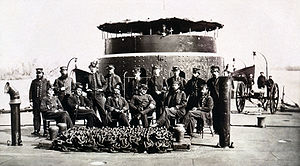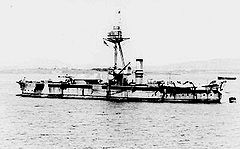- Monitor (warship)
-
This page is about the Monitor type of warships. For the U.S. Navy warship which gave its name to this type, see USS Monitor.
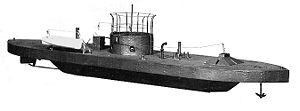 The USS Monitor, the first monitor (1861).
The USS Monitor, the first monitor (1861).
A monitor was a class of relatively small warship which was neither fast nor strongly armoured but carried disproportionately large guns. They were used by some navies from the 1860s until the end of World War II, and saw their final use by the United States Navy during the Vietnam War.[1]
The monitors of the 19th century were turreted ironclad warships inspired by the original USS Monitor; as well as coastal ships which closely followed her design. The term "monitor" also encompassed more flexible breastwork monitors, and was sometimes used as a generic term for any turreted ship.
The term "monitor" also represents the strongest of riverine warcraft, known as river monitors. In the early 20th century, the term "monitor" was revived for shallow-draft armoured shore bombardment vessels, particularly those of the British Royal Navy: the Lord Clive class monitors carried guns firing heavier shells than any other warship ever has, seeing action (albeit briefly) against German targets during World War I. The Lord Clive vessels were scrapped in the 1920s.
Contents
Nineteenth century
 The CSS Virginia.
The CSS Virginia.
American Civil War
In Latin, a monitor is someone who admonishes—that is, reminds another of his duties—which is how USS Monitor was given its name.[citation needed] She was designed by John Ericsson for emergency service in the Federal navy during the American Civil War and was designed to serve in shallow water and to present as small a target as possible, the water around her acting as protection.
The Battle of Hampton Roads, between the Monitor and CSS Virginia, was the first engagement between ironclad vessels. There were several such battles over the course of the American Civil War and the dozens of monitors built for the United States Navy reflected a ship-to-ship combat role in their designs. However, fortification bombardment was another crucial role that the early monitors played, and one that these early designs were much less capable in performing.
Three months after the Battle of Hampton Roads, John Ericsson took his design to his native Sweden, and in 1865 the first Swedish monitor was built at Motala Warf in Norrköping, taking the engineer's name. She was followed by 14 more monitors. One of them, Kanonbåten Sölve, served until 1922 and is today preserved at the marine museum in Gothenburg.
Ericsson and others experimented greatly during the years of the American Civil War. Vessels constructed included: a triple turreted monitor, a class of paddlewheel propelled monitors, a class of semi-submersible monitors, and a class of monitors armed with spar torpedoes.
1866 to 1878
In the 1860s and 1870s several nations' navies built monitors that were used for coastal defense and took the name monitor as a type of ship. Those that were directly modelled on the Monitor were low-freeboard, mastless, steam-powered vessels with one or two rotating, armoured turrets. The low freeboard meant that these ships were unsuitable for ocean-going duties and were always at risk of water entering the ship and causing flooding and possible loss, but it reduced the amount of armour required for protection, and in heavy weather the sea would wash over the deck rather than heeling the ship over.
Attempts were made to design monitors with sail rigs, to overcome the reliance on the steam engine, which, besides its technical problems, was still met with antipathy in some navies.
The provision of masts interfered with the turrets' ability to operate in a 360 degree arc of fire and the weight of mast and sail aloft made the ships less stable. One ship, HMS Captain, which combined turret and sails with a low freeboard was lost in heavy weather.
War of the Pacific
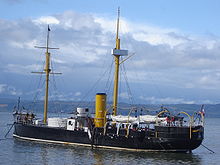 Huáscar anchored in the harbour at Talcahuano.
Huáscar anchored in the harbour at Talcahuano.
A late example of a vessel fairly directly modeled on the Monitor was the Huáscar, designed by Cowper P. Coles, the advocate and developer of turret ships for the Royal Navy. Huáscar was one of many monitor designs to be equipped with a ram. She was launched in 1865 at Birkenhead, England and attained fame serving at the Battle of Pacocha during the Peruvian Civil War of 1877. Huascar, under the command of Rear Admiral Miguel Grau, fought with distinction during the War of the Pacific.
Huascar successfully raided enemy sea lanes for several months and delayed an invasion of Chilean Army to Peruvian territory until captured by the Chilean Navy at the Battle of Angamos in 1879. Once in Chilean hands, Huascar fought a small battle with the Peruvian monitor, Manco Capac during the bombardment of Arica, which resulted in the scuttling of Manco Capac to prevent capture.
Over the years, both Chile and Peru have come to venerate the ship and the officers from both sides that died on her deck, either commanding her or boarding her, as national heroes. Huáscar is currently commissioned in the Chilean Navy, has been restored to a near-original condition and, as a museum ship, is open to visitors at its berth in Talcahuano.
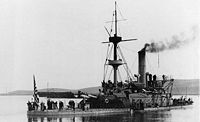 The USS Monterey, a breastwork monitor, at Mare Island Naval Shipyard, c.1896. The older, Ericsson-designed, monitor USS Camanche is visible in the background.
The USS Monterey, a breastwork monitor, at Mare Island Naval Shipyard, c.1896. The older, Ericsson-designed, monitor USS Camanche is visible in the background.
1884–1897
In an effort to produce a more seaworthy vessel that was more capable in ship-to-shore combat, a variation called the breastwork monitor started to become more common in the later nineteenth century. These ships had raised turrets and a heavier superstructure on a platform above the hull.
These were still not particularly successful as seagoing ships, because of the short sailing range due from the low efficiency and poor reliability of the steam engines they used. The first of these ships was the HMVS Cerberus, built between 1868 and 1870. She was sunk as a breakwater near Melbourne, Australia and is still visible there, as her upper works project from the water.
Spanish-American War
Monitors were used frequently during the Spanish-American War in 1898. Notable United States Navy monitors which fought in the war were the USS Amphitrite, USS Puritan, USS Monterey and USS Terror. These four monitors fought at battles or campaigns such as the Bombardment of San Juan, Battle of Fajardo and the Philippines Campaign. Other monitors participated in the conflict also.
Twentieth century
World War I
During World War I, the Royal Navy developed several classes of ships which were designed to give close support to troops ashore. Termed "monitors", they owed little to the monitors of the 19th century, though they shared the characteristics of poor seaworthiness, shallow draft and heavy armament in turrets.
The first class, the Humber class, had been laid down as large river gunboats for the Brazilian navy. Later monitor classes were equally makeshift; they were often designed around whichever spare guns were available from ships scrapped or never built, with the hulls quickly designed and built in "cheap and cheerful" fashion. They were broad beamed for stability (beam was about 1/3 of the overall length) which together with a lack of emphasis on speed made them extremely slow, and they were not suitable for naval combat or any sort of work on the high seas. Monitors of the Royal Navy played a part in consolidating the left wing of the Western Front during the Race to the Sea in 1914.
To these were added monitors built during the course of the war. Their armament was typically a turret taken from a de-commissioned pre-dreadnought battleship. These monitors were built from the start with protection against torpedo attack — waterline bulges were incorporated into the Abercrombie class of 1915.[2] As the war settled to its longer course, these heavier monitors formed patrols along with destroyers on either side of the Straits of Dover to exclude enemy surface vessels from the English Channel and keep the enemy in port. The monitors could also operate into the river mouths. The General Wolfe, one of the Lord Clive class monitors, which had a single 18-inch (457 mm) gun added in 1918, was able to shell a bridge 20 miles (30 km) away near Ostend. Other RN monitors served in the Mediterranean.
The dimensions of the several classes of monitor varied greatly. Those of the Abercrombie class were 320 ft (116 m) by 90 ft (27.4 m) in the beam and drew 9 ft (3 m) compared to the M29 class monitors of 1915 that were only 170 ft (52 m) long. and the Erebus class of 1916 were 405 ft (123.5 m) long. The largest monitors carried the heaviest guns.
By this point the United States Navy had largely stopped using monitors. Only a few still existed, of which only seven were still in service, all of which had been relegated to being submarine tenders. This would be the last war in which United States monitor-type vessels would see commissioned service.
World War II
The smaller Royal Navy monitors were mostly scrapped following World War I, though Erebus and Terror survived to fight in World War II. When the requirement for shore support returned, two large new Roberts class monitors, Roberts and Abercrombie, were constructed and fitted with 15-inch (380 mm) guns from older battleships.
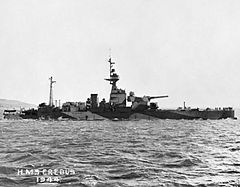 HMS Erebus during World War II.
HMS Erebus during World War II.
Allied monitors saw service in the Mediterranean in support of the British Eighth Army's desert and Italian campaigns. They were part of the offshore bombardment for the Invasion of Normandy in 1944.
1946–1964
 HMS Abercrombie (F109), 1946.
HMS Abercrombie (F109), 1946.
The Royal Navy still had HMS Abercrombie (completed 1943) and Roberts (1941) in reserve in 1953. They were typical monitors, trunk-decked vessels, some 373 feet (114 m) long overall, 90-foot (27 m) in the beam and with an 11-foot (3 m) mean draught carrying two 15-inch (381 mm) guns.
The Brazilian Navy presently operates the last true "monitor" as part of their inland waterway force, the Parnaíba (U17)
Vietnam War
The Vietnam War was the U.S. Navy's second riverine war; the first having taken place a century earlier in 1861, during the American Civil War. On 18 December 1965, the U.S. Navy, for the second time in a hundred years, authorized the re-activation of a Brown Water Navy, this time in the Republic of Vietnam (RVN). After studies were conducted, plans were drawn up by the U.S. Naval Advisory Group (NAFP) in February 1966, and by the summer of 1966 Secretary of Defense Robert S. McNamara authorized the U.S. Navy a Mobile Riverine Force (MRF).[3]
Although U.S. Navy Patrol Craft Fasts (Swift Boats), PBRs (Patrol Boat River), and assorted gunboats had been operating COIN (counter-insurgency operations) in country prior to 1966; the allies were not gaining success in the Mekong Delta regions of the Republic of Vietnam. But the communists were. A stronger naval force was needed, one that was heavily armored, and heavily gunned.
The U.S. Navy's MRF, initially consisted of River Assault Flotilla One, under Program 4 in 1967, and consisted of four River Assault Divisions: RAD-91 which contained 3 Monitors; RAD-92 which contained 2 Monitors; RAD-111 had 3 Monitors; and RAD-112 operated 2 Monitors. These river battleships[4] as known by the men, operated in conjunction with the CCB (Command Control Boat-also a Monitor), ATCs (Armored Transport Carriers), and the ASPBs (Assault Support Patrol Boats) which were also assigned to each RAD.[5]
Vietnam Monitors were originally converted from World War II 56-foot-long all steel Landing Craft Mechanized (LCMs) Mark 6s. They were constructed under two phases; Programs 4 & 5. Under Program 4, 10 Monitors were armed with one 40mm cannon and then fielded. Program 5 Monitors would correct any deficiencies from the previous vessels, and were fielded as the Monitor (H) 105mm (Howitzer) and the Monitor (F) (Flamethrower).[6] The Program 4 Monitors mounted their single barrel 40mm cannon in a Mk 52 turret; while the Program 5 Monitors mounted their 105mm cannon in a T172 turret, and the six Flamethrowers were mounted in M8 cupula turrets (one on each side of the vessel's 40mm turret).[7] Because the U.S. Marine Corps was also using the M49 105mm howitzer, there was a shortage, and only 8 Monitor (H) versions could be procured for the Brown Water Navy.
As fielded, the 24 Monitors of the U.S. Navy in Vietnam averaged about 10 tons of armor, were about 60' long, had two screws, were powered by two 64NH9 diesel engines, 8.5 knots (maximum speed), 17½' wide, 3½' draft, and were normally manned by 11 crewmen. When South Vietnam fell on 30 April 1975, all Monitors fell into the enemy's hands; leaving only one survivor, a training Monitor, that never left the US. "Training" Monitor #C-18 is on display, along with one PCF (Swift Boat), and one PBR (Patrol Boat River) at the U.S. Naval Amphibious Base in Coronado, California.
Similar vessels
River monitors
The monitor, by proving the efficacy of turrets over fixed guns, played a part in development of the dreadnought battleship from the ironclad. As a shallow draft vessel it also led to the river gunboats which were used by imperial powers to police their colonial possessions; indeed the largest and most heavily armed river gunboats became known as river monitors. They were used by several navies, including the British Empire, the United States and Japan.
Submarine gunboats
USS Monitor had had very little freeboard so as to bring the mass of the gun turret down, thereby increasing stability and making the boat a smaller and therefore harder target for gunfire. At the end of the American Civil War, the U.S. Navy Casco-class monitors had large ballast tanks that allowed the vessels to partially submerge during battle. This idea was carried further with the concept of the Royal Navy's R class of submarine gunboats.
The British M class submarines were initially designed for shore bombardment, but their purpose was changed to attacking enemy merchant vessels as their 12-inch (305 mm) gun would be more effective at long range than a torpedo against a moving target. Only one, HMS M1, entered service before the end of World War 1; she was lost in the English Channel after the war in 1925 after being accidentally rammed while submerged: her gun came free of its mount and she was completely flooded.
 USS Casco in the James River, 1865.
USS Casco in the James River, 1865.
Derivative uses of the name
To overcome the stability problems arising from the heavy turret mounted high in monitors, their hulls were designed to reduce other top weight. After Ericsson's ships, monitors developed the trunk deck design as the upper deck had to be heavily armoured against plunging shells. Because of the weight high in the hull, its breadth was minimized, giving rise to a vessel broad-beamed at the waterline, but with a narrow upper deck.
By analogy, nineteenth century railway coaches which were of the same shape to accommodate ventilators and lamps above the heads of standing passengers in the centre while to the sides, passengers were seated, were called monitors or monitor cars in the U.S.; the raised part of the roof was known as a turret. In ship design of around 1900, a turret deck was a more austere version of the trunk deck.
Surviving vessels
 HMS M33 is an M29-class monitor of the Royal Navy built in 1915; she is preserved at Portsmouth Historic Dockyard in the United Kingdom.
HMS M33 is an M29-class monitor of the Royal Navy built in 1915; she is preserved at Portsmouth Historic Dockyard in the United Kingdom. HMVS Cerberus, launched in 1870, was scuttled as a breakwater off the Australian coast at in 1926. Work for her salvage and restoration is proceeding.
HMVS Cerberus, launched in 1870, was scuttled as a breakwater off the Australian coast at in 1926. Work for her salvage and restoration is proceeding. The Parnaíba is a river monitor currently in service with the Brazilian navy.
The Parnaíba is a river monitor currently in service with the Brazilian navy. HMS Sölve Is a Swedish monitor built 1875 and designed by John Ericsson the "father" of all Monitors. Currently in a Maritime Museum in Gothenburg Sweden
HMS Sölve Is a Swedish monitor built 1875 and designed by John Ericsson the "father" of all Monitors. Currently in a Maritime Museum in Gothenburg Sweden Huáscar has been restored to near-original condition and is open to visitors at its berth in Talcahuano as a museum ship.
Huáscar has been restored to near-original condition and is open to visitors at its berth in Talcahuano as a museum ship.
See also
- List of monitors of the Royal Navy
- Abercrombie class monitor. HMS Abercrombie mentioned above was of the later, Roberts class.
- Erebus class
- Lord Clive class
- Marshal Ney class
- M29 class An example of this class is HMS M33.
- Roberts class
- The Dover Patrol
- Coastal defence ship
- List of monitors of the United States Navy
The "Laya Monitor" from the Hungarian Navy is docked in the Danube river in Budapest for tourists to go through. It was built in 1878 after the U.S. Monitor. It has a double gun in the turret house. Machine guns on both sides of the ship provide added power. It fought the Russians in the first anti-communist battle in the early 20th century. It was in the World War one battle of Romania.
References
- Anon. Jane's Fighting Ships 1953-54 (1953)
- Carrico, John M. Vietnam Ironclads, A Pictorial History of U.S. Navy River Assault Craft, 1966–1970. (2007) Brown Water Enterprises. ISBN 978-0-9794231-0-9.
- Churchill, W.S. The World Crisis 1911–1918 (1938) Chapter XVI
- Oxford English Dictionary
- Friedman, Norman. U.S. Small Combatants: An Illustrated Design History. (1987) U.S. Naval Institute Press. ISBN 0-87021-713-5.
- Konstam, Angus The Duel of the Ironclads (2003) ISBN 1-84176-721-2
External links
 Media related to Monitor warships at Wikimedia Commons
Media related to Monitor warships at Wikimedia Commons- HMS Monitor M33 at Portsmouth Naval Dockyard
- Photos aboard USS Monitor
- Pictures of early twentieth century monitors
- The service record of M33
- M (monitor) class submarines
- Erebus class statistics
- The trunk-deck design of HMS Roberts shows clearly in this photograph
Categories:- Ship types
- Monitors
Wikimedia Foundation. 2010.

